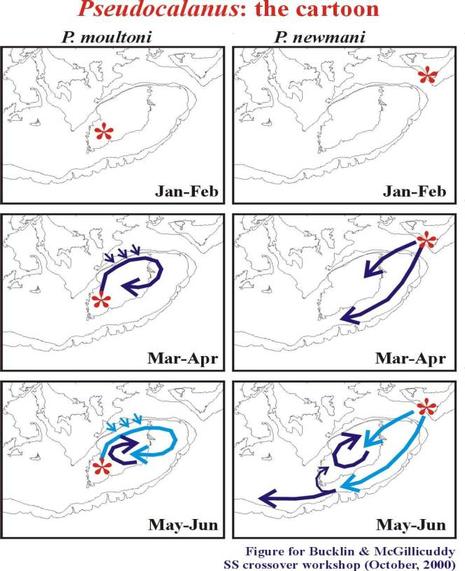Cross-Frontal Exchange and Scotian Shelf Cross-over Workshops
10-12 October, 2000
Holiday Inn, Falmouth, Massachusetts
|
Cross-Frontal Exchange and Scotian Shelf Cross-over Workshops 10-12 October, 2000 Holiday Inn, Falmouth, Massachusetts |
|
Overview
Cross-Frontal Exchange
Presentations
|
Role of Scotian Shelf Cross-over Events in Maintenance of Pseudocalanus spp. on Georges Bank Ann Bucklin (UNH) and Dennis McGillicuddy (WHOI) Two cryptic copepod species, Pseudocalanus moultoni and P. newmani, co-occur on Georges Bank. Despite their morphological similarity, the species differ in seasonal patterns of distribution and abundance over the Bank and adjacent regions. We hypothesize the P. moultoni may be maintained within the 60 m isobath (over the crest of the Bank) by in situ reproduction and advection in the seasonally-intensifying cyclonic gyre. The species first appears over the western half of Bank crest and becomes concentrated over the crest during May and June in both 1997 and 1999 (Fig. L1 below). In contrast, P. newmani appears first in the northeast corner of the sampling domain (over Browns Bank). Subsequent monthly snapshots suggest that the species is carried by Scotian Shelf crossover events onto the southern flank of the Bank, and thereafter rapidly lost from the Bank. An alternate hypothesis (which we are exploring using samples collected in the Gulf of Maine during October and December, 1998), is that P. newmani is transported onto the crest from the Gulf of Maine, carried in the jet along the northern flank of the Bank. Our hypotheses about the importance of crossover events for delivery of P. newmani onto the crest of the Bank are based on monthly Broadscale Survey maps, adjoint modeling, and comparison with drifter studies. We expect that a crossover event may seed the production of P. newmani on the Bank in a lucky confluence of events: i.e., the crossover transports reproductively active females and it is followed by a weather window sufficient to allow egg production, survival of surface-dwelling nauplii, and maturation to deeper-dwelling copepodites, which may then be retained. These hypotheses can be examined by comparing P. newmani abundances on the Bank in years with different frequencies of crossover events. E.g., P. newmani was relatively less abundant during 1997 (with fewer events) and relatively more abundant during 1999 (with more frequent and persistent crossover events). 
Figure L1. Drift scenarios for life histories of Pseudocalanus spp. on Georges Bank. |